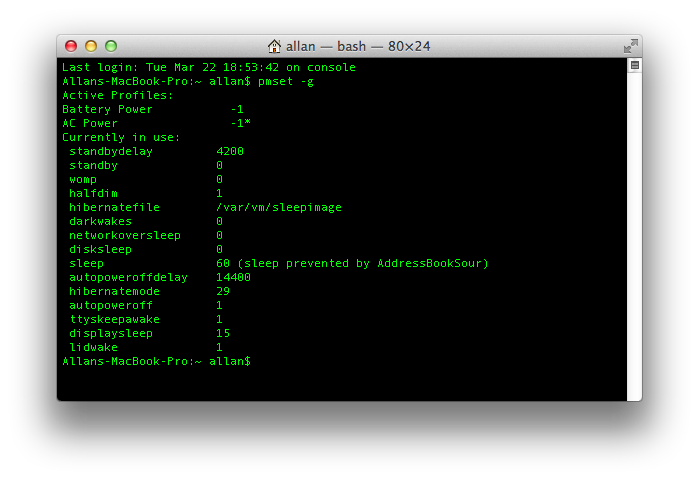It's safe to say that nearly every Mac user wants to update to the newer macOS versions. However, what they do not know is that even a stable macOS like High Sierra or Mojave has its disadvantages. That means if you are thinking about an upgrade, you have to prepare to troubleshoot some issues at some point.
- When Apple announced new PowerBooks in October 2005, it also introduced Safe Sleep to Mac OS X, an extension to Sleep mode that allows for hibernation without power.
- Hibernate is a simple command line program to put macOS 10.12 or newer into hibernation mode. This is archieved by modifying the power management preferences and initiating system sleep. After the system has powered on, the power management preferences are restored to their previous state.
- Hibernation takes longer than just putting it to sleep, and only 1% of your battery charge is used for one hour of sleep. Setting it manually, setting it automatically. To learn more about Mac OS.
- Quicksilver 867, Pismo 500, G5 dual 2, Macbook C2D, Mac OS X (10.4.10) Posted on Mar 7, 2008 9:33 AM.
On your Mac, choose Apple menu System Preferences, then click Energy Saver. Open Energy Saver preferences for me. Do any of the following: Set your Mac to go to sleep and wake up at a specific time: Click Schedule in the bottom-right corner, then select the options you want to use. See Schedule your Mac desktop computer to turn on or off.
One of the most common issues with High Sierra is the sleep-wake failure, which causes a MacBook not to wake up from sleep or just randomly restart itself. After some Mac users updated to High Sierra or Mojave, they reported having this problem, where they find it difficult to wake their devices from sleep. Regardless of the model or type of Apple computer they're using, they just cannot wake up their devices from sleep.
But how does this sleep function activate?
Putting Your Mac in Sleep Mode
The sleep mode is only an optional feature, but it is quite handy for Mac users who need to regularly take a break from using their devices yet forget to switch them off. It's also a useful feature that can help you achieve your energy-saving goals.
Pro Tip: Scan your Mac for performance issues, junk files, harmful apps, and security threats
that can cause system issues or slow performance.
Special offer. About Outbyte, uninstall instructions, EULA, Privacy Policy.
To activate this feature, do the following:
- Open the Apple menu.
- Go to System Preferences > Energy Saver.
- Apply the settings you want. You can set the display to switch off after a certain span of time. You can also make the hard drive sleep if you want.
- Once you're satisfied with the settings, hit Apply.
Waking Up Your Mac from a Long Sleep

So, you have just upgraded to High Sierra or Mojave and your computer has entered sleep mode. Now, you are faced with a sleep-wake failure issue. What should you do?
Don't panic! There is a way to fix MacBook sleep-wake failures. Below, we've listed the most obvious and effective solutions to resolve your problem, and you can try all of them as needed.
1. Check Your Power and Screen Brightness.
Before you do anything, you need to check the most obvious possibilities. Is your screen brightness set to a minimum? Is your Mac powered on? If you are using an external display, is it actually switched on? Is your Mac plugged into a power source? If you are using a MacBook, is the battery drained?
Oftentimes, your Mac may not be in sleep mode. It is possible that its screen brightness might just be adjusted down lower. It is also likely that your MacBook is just turned off. Simply adjusting the brightness or switching on your Mac can resolve your sleep-wake failure nightmares.

So, you have just upgraded to High Sierra or Mojave and your computer has entered sleep mode. Now, you are faced with a sleep-wake failure issue. What should you do?
Don't panic! There is a way to fix MacBook sleep-wake failures. Below, we've listed the most obvious and effective solutions to resolve your problem, and you can try all of them as needed.
1. Check Your Power and Screen Brightness.
Before you do anything, you need to check the most obvious possibilities. Is your screen brightness set to a minimum? Is your Mac powered on? If you are using an external display, is it actually switched on? Is your Mac plugged into a power source? If you are using a MacBook, is the battery drained?
Oftentimes, your Mac may not be in sleep mode. It is possible that its screen brightness might just be adjusted down lower. It is also likely that your MacBook is just turned off. Simply adjusting the brightness or switching on your Mac can resolve your sleep-wake failure nightmares.
2. Switch Off Your Mac and Turn It Back On.
This step involves forcibly turning off and then turning on your Mac. Doing this will allow you to access your computer again and possibly fix your sleep-wake failure problem. To force-restart your Mac, follow these instructions:
- Hold down the Power button for a few seconds until your Mac shuts down.
- Wait for 10 to 15 seconds and switch on your Mac again.
- Check if the problem persists.
3. Perform an SMC and NVRAM Reset.
Performing an SMC and NVRAM reset is a common troubleshooting technique used to fix display and power issues. If your Mac repeatedly gets stuck on a blank screen every time you wake it up from sleep, you should try resetting the SMC and NVRAM.
Here's how to perform an SMC and NVRAM reset:
- Switch off your Mac.
- Disconnect the power cord.
- Hold down the Shift, Control, Option, and Power buttons for 10 seconds.
- Release the keys together.
- Reconnect the power cord.
- Switch on your Mac again.
- Reboot your Mac again, but this time, hold down the Option, Command, P and R keys for 20 seconds.
4. Reinstall MacOS.
If you've already adjusted your display's brightness, checked your connection, and performed an NVRAM and SMC reset yet your Mac continuously wakes up to a black screen, you might need to reinstall your macOS.
Don't worry, because you can always reinstall your macOS without having to format your computer completely. The general rule of thumb, however, is to have a backup first before resetting your OS. You'll realize the importance of a backup once you experience data loss.
5. Disable System Hibernation.
Aside from the sleep mode, your Mac also has a hibernation mode, which is also optional. The hibernation mode is a helpful, preventive feature that allows you to keep data in the event when there is no power. However, even without this mode, you can still proceed with your daily tasks.
If you don't need to hibernate your Mac and you frequently have problems with waking up your computer from sleep, try disabling the hibernate mode. To do this, run these commands in your OS X Terminal:
- sudo pmset standby 0
- sudo pmset autopoweroff 0
These commands will disable the settings of the hardware that are responsible for activating the hibernate mode. If you ever decide to activate this setting again, simply run the commands in your OS X Terminal, but this time, change the value 0 to 1.
6. Reset Your Mac's FileVault.
It is possible that a glitch is stopping your system from retrieving all necessary contents and files on your hard drive, which are required to wake up your Mac from sleep. As a result, conflict arises between your full-disk encryption protocols like FileVault and your system crashes when it wakes up.
To resolve this issue, try disabling your full-disk encryption protocols. Next, decrypt your hard drive using third-party tools. After that, re-enable your full-disk encryption protocols. See if this solves your problem.
7. Get Rid of System Junk.
Hibernation (audrith) Mac Os Downloads
System junk, including cache files, broken downloads, diagnostic reports, and unwanted file logs may have built up in your system over time. If not removed, they can take up valuable space in your drive and worse, interfere with your system activities.
To get rid of system junk, you need to download and install a third-party tool like Outbyte MacRepair. Use it to run a quick scan on your system, empty your trash bin, and delete any unwanted files from all common locations.
What's Next?
Are you still having problems with waking up your Mac from sleep? The best thing you should do is to contact Apple's support team or bring your Mac to the nearest Apple Store for service.
Though it rarely happens, it is possible that a hardware problem is keeping your Mac from waking up from sleep. Just make sure you contact authorized support or a legit repair center for the best results.
Mac Os Versions
Let us know what solutions helped you solve your Mac sleep-wake failure problems. Comment them below!
Hibernation (audrith) Mac Os Catalina
See more information about Outbyte and uninstall instructions. Please review EULA and Privacy Policy.

